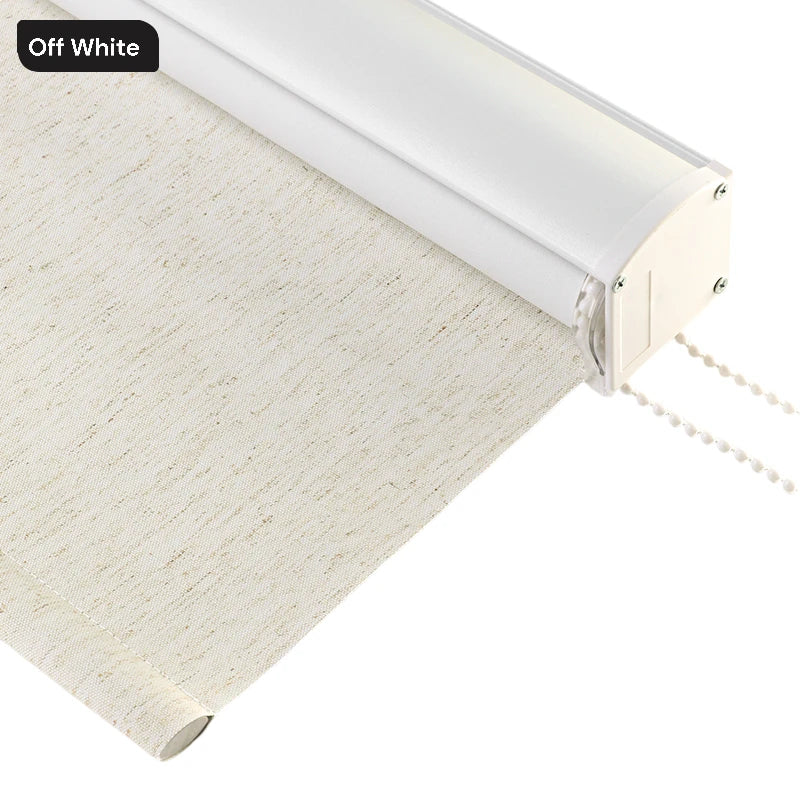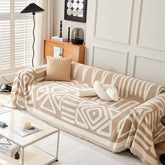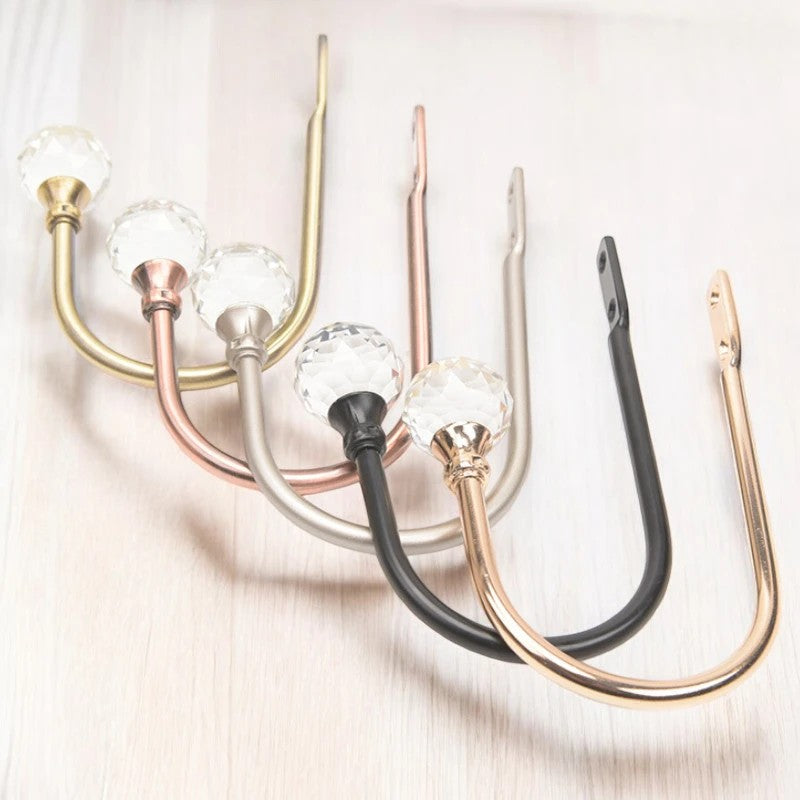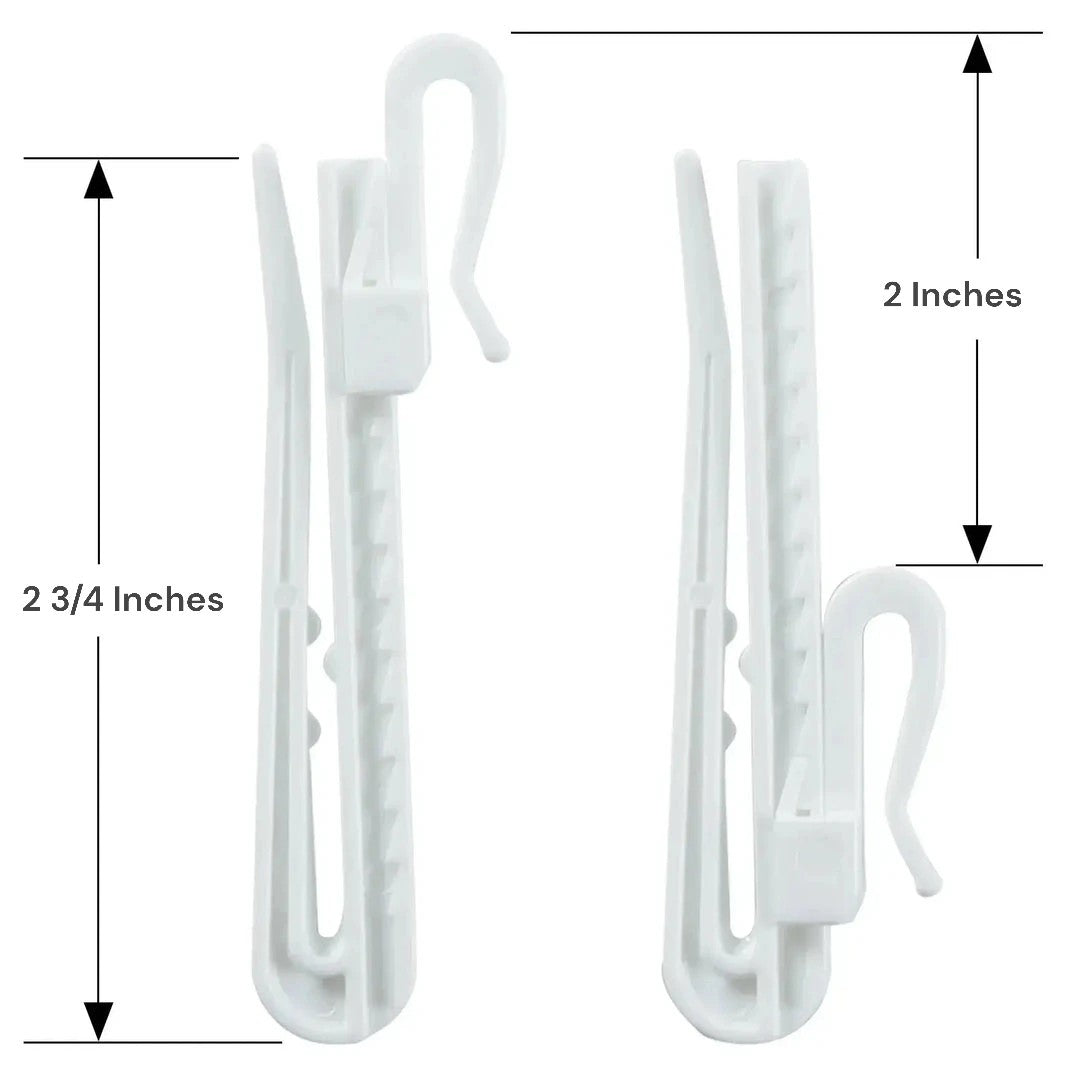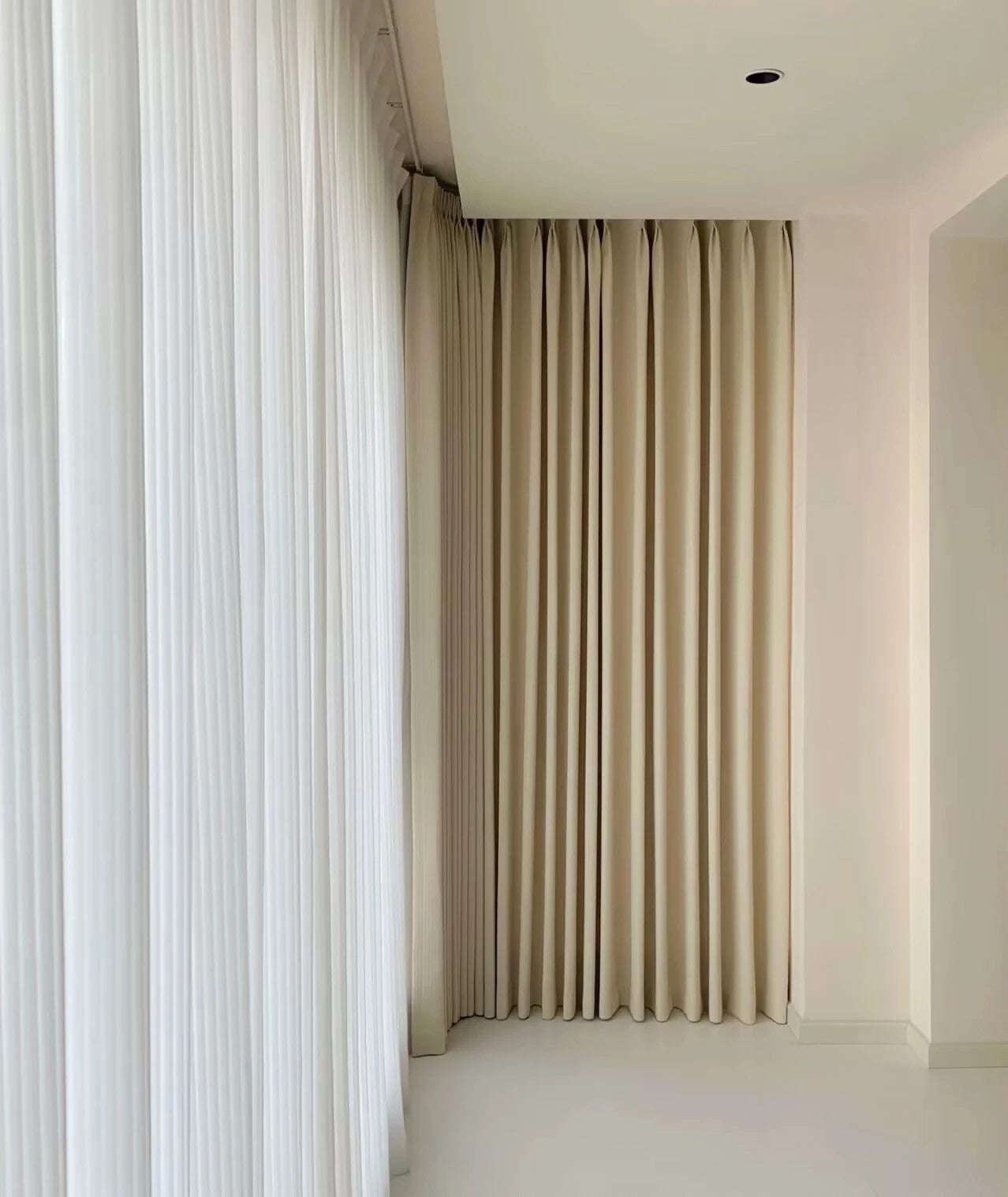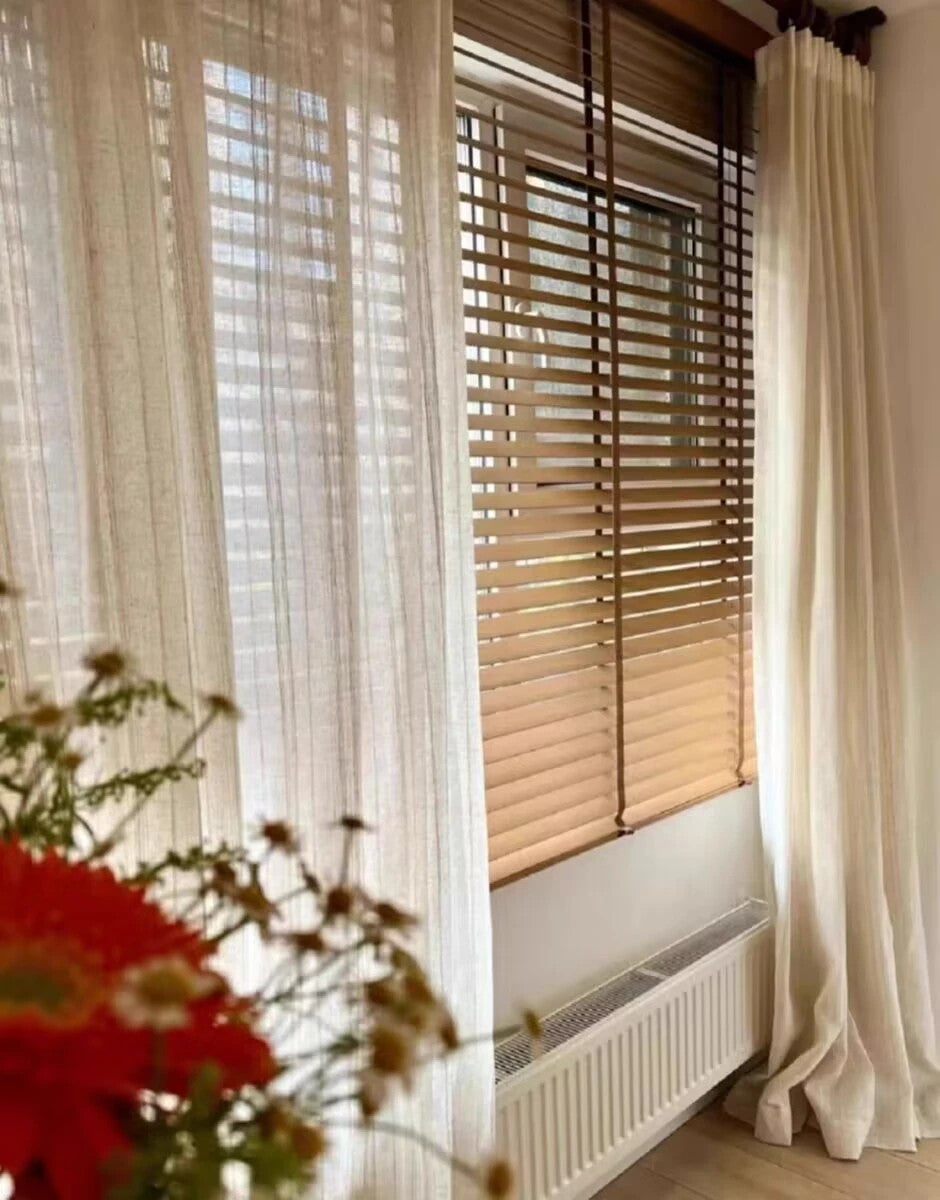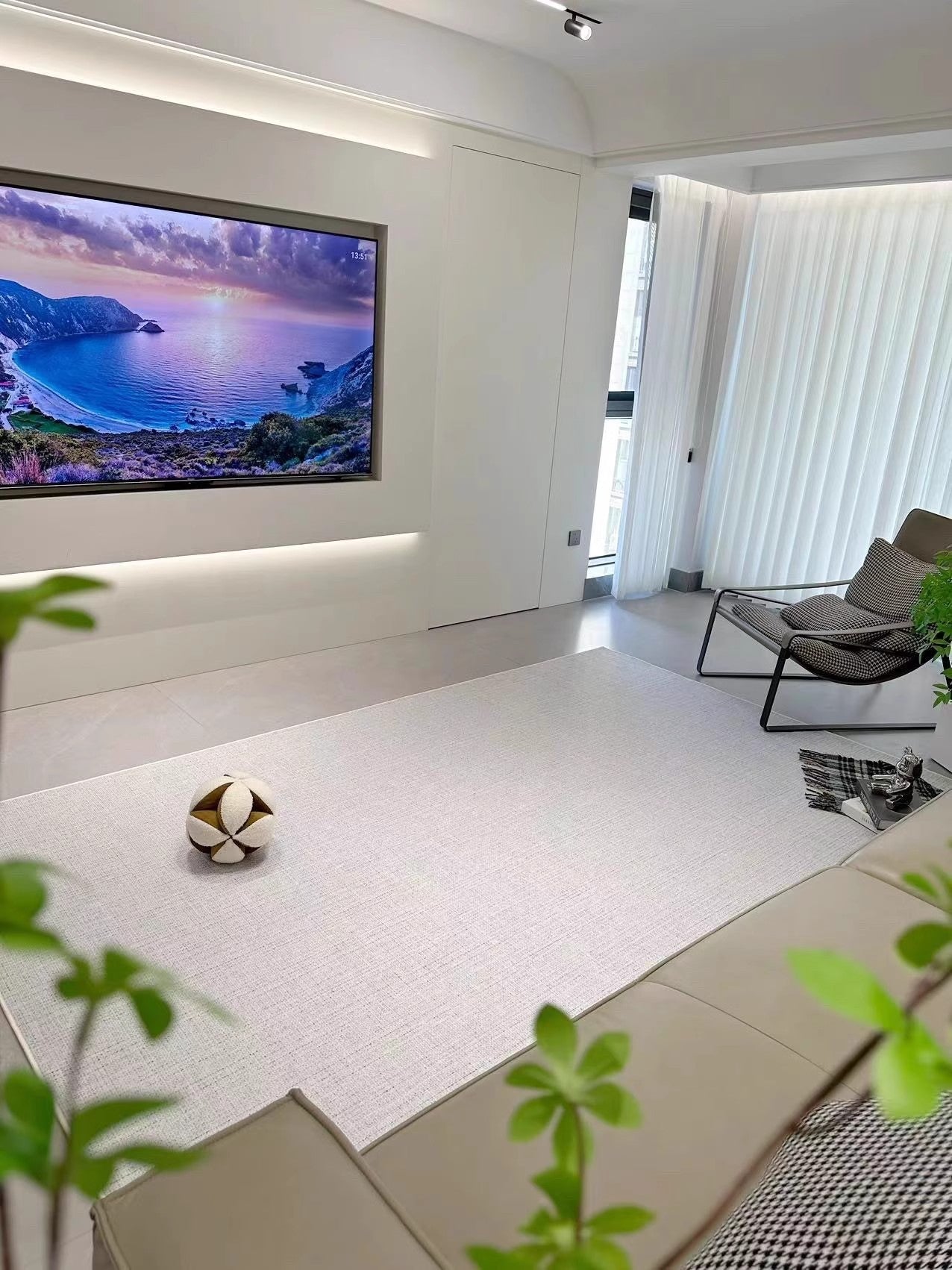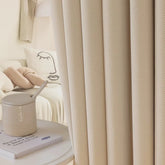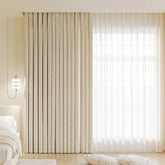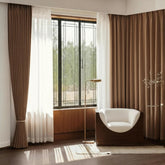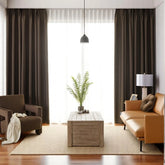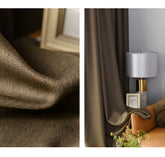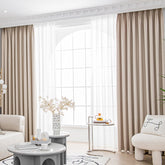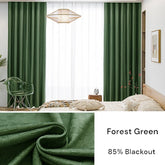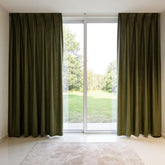Cortinas térmicas vs. película para ventanas: ¿mejor aislante?
Última actualización: abril de 2025
Como propietario de Dolcewe.com, he ayudado a miles de clientes a encontrar las mejores opciones de aislamiento para ventanas. Muchos propietarios me preguntan si las cortinas térmicas o el film para ventanas funcionan mejor.
Aunque cada opción promete mejorar la eficiencia energética de una casa y reducir los costos de calefacción y refrigeración, sus beneficios aislantes varían.
Te guiaré a través de un análisis, desvelando las capas (literalmente) sobre cómo funcionan estas cubiertas para ventanas, para que otros propietarios puedan tomar una decisión informada.
Puntos clave
| Sección Principal | Conclusión Clave |
|---|---|
| ¿Qué Son las Cortinas Térmicas? | Las cortinas térmicas con múltiples capas pueden reducir la pérdida de calor hasta en un 25% a través de las ventanas. Para mejores resultados, elija cortinas a medida que cubran todo el marco de la ventana sin espacios y ciérrelas durante las partes más frías o calientes del día. |
| ¿Qué es la Película para Ventanas? | La película para ventanas proporciona aislamiento durante todo el año sin bloquear su vista mientras bloquea los rayos UV dañinos que desteñen los muebles. Aplique película clara para máxima visibilidad o película tintada para bloqueo extra de calor en áreas soleadas. |
| ¿Qué opción aísla mejor? | Las cortinas térmicas ofrecen mayor poder de aislamiento (valor R 3-5) pero solo funcionan cuando están cerradas, mientras que la película para ventanas funciona constantemente con menor aislamiento (valor R 1-3). Considere usar ambos para máximo ahorro energético: la película funciona todo el día y las cortinas añaden aislamiento extra durante temperaturas extremas. |
| Comparación de Costos | Ambas opciones típicamente se amortizan en 1-3 años mediante ahorros energéticos de $100-275 anuales. Las cortinas térmicas personalizadas desde $26.99 ofrecen excelente valor con costos mínimos de instalación, mientras que la película para ventanas requiere instalación más cuidadosa pero puede durar más. |
| Cómo instalar: Consejos de bricolaje | Instale cortinas térmicas 4-6 pulgadas más anchas que su ventana y monte la barra lo suficientemente alta para evitar fugas de calor en la parte superior. Para la película para ventanas, trabaje despacio con spray de agua jabonosa y una escobilla, comenzando desde arriba hacia abajo para minimizar burbujas. |
| Impacto en el diseño y estilo | Elija entre más de 200 opciones de tela para combinar con su decoración mientras añade eficiencia energética. Coloque cortinas transparentes debajo de las térmicas para flexibilidad: mantenga las transparentes cerradas durante el día para privacidad mientras permite la entrada de luz, luego cierre las térmicas cuando necesite aislamiento. |
| Durabilidad y Cuidado | Lave las cortinas térmicas 1-2 veces al año y aspire regularmente para mantener las propiedades de aislamiento y extender su vida útil de 5-10 años. Limpie la película para ventanas con limpiador estándar, pero evite materiales abrasivos que puedan rayar la superficie, ayudándola a alcanzar su potencial vida útil de 15 años. |
| Mejor opción para diferentes hogares | Los inquilinos deben elegir cortinas térmicas por su fácil instalación y remoción sin cambios permanentes. Los propietarios pueden beneficiarse de la película para ventanas para un valor a largo plazo, o combinar ambos métodos para máxima eficiencia energética. |
| ¿Qué es lo mejor para tu clima? | En climas fríos, elija cortinas térmicas de triple capa y selle cualquier espacio alrededor de los marcos de las ventanas con burletes. Para regiones cálidas y soleadas, instale película reflectante para ventanas y agregue cortinas térmicas de color claro para maximizar la reflexión del calor. |
Beneficios de las Cortinas Térmicas

Profundicemos en lo que hace que esta solución para ventanas sea una elección inteligente para quienes buscan combatir los elementos mientras mejoran el interior de su hogar.
Entendiendo las Cortinas Térmicas
Cuando consideré por primera vez cortinas térmicas para mi hogar, me intrigó su estructura.
Cortinas térmicas tienen capas especiales que bloquean la transferencia de calor a través de las ventanas. La mayoría tiene tres o cuatro capas de tela en total.
La capa exterior se ve bien en tu habitación. Las capas intermedias atrapan aire para bloquear el calor. El respaldo a menudo tiene espuma u otro material que bloquea el calor.
La belleza está en su capacidad para interrumpir el proceso de intercambio de calor, que he encontrado
Aislamiento
Estas cortinas crean una barrera entre tu habitación y la ventana. Mantienen el aire cálido dentro durante el invierno. En verano, bloquean la entrada de aire caliente.
Un estudio muestra que Pueden reducir la pérdida de energía térmica en aproximadamente un 25%. Así que puedes ahorrar mucho en tus facturas de energía. Suena genial, ¿verdad?
Artículo relacionado - beneficios de las cortinas en capas
En Dolcewe.com, fabricamos cortinas térmicas personalizadas desde $26.99. Puedes elegir cualquier tamaño para que se ajusten perfectamente a tus ventanas. Sin espacios significa mejor bloqueo del calor.
Cómo las cortinas térmicas te ayudan:
- Detén las corrientes de aire frío de las ventanas
- Haz que las habitaciones se sientan más cálidas
- Reduce los costos de calefacción y refrigeración
- Reduce el ruido del exterior
- Bloquea la luz cuando sea necesario
- Añade estilo a tu habitación
He vendido cortinas térmicas por más de 10 años. Los clientes me dicen que sus habitaciones se sienten más cálidas de inmediato después de colgarlas.
Artículo relacionado - guía de cortinas aislantes
Mi hogar es mi santuario del ruido de las calles bulliciosas. Las propiedades de reducción de sonido de las cortinas térmicas añaden una capa de tranquilidad acústica, amortiguando notablemente el bullicio de la vida diaria, un beneficio que el film para ventanas simplemente no puede ofrecer.
| Característica | Cortinas térmicas | Película para ventanas |
|---|---|---|
| Material | Capa de espuma y lámina metálica | Film laminado delgado |
| Función | Aísla y refleja el calor | Refleja los rayos UV dañinos y el calor solar |
| Control de luz | Opción completa de oscurecimiento total disponible | Reduce el deslumbramiento pero permite el paso de algo de luz |
| Privacidad | Material opaco que garantiza privacidad | Varía según el tipo de film, es posible cierta visibilidad |
| Variedad estética | Amplia variedad de texturas y diseños | Opciones mayormente transparentes o tintadas |
| Aislamiento acústico | Buenas propiedades de reducción de sonido | No aísla el sonido |
Beneficios del film para ventanas

El film para ventanas es una lámina delgada que se adhiere directamente a tu vidrio. Está hecho de plástico, usualmente poliéster. El film viene en rollos que cortas para ajustar. Algunos films son transparentes. Otros tienen tintes o patrones.
El film para ventanas funciona cambiando cómo se mueve el calor a través del vidrio. Devuelve el calor a su lugar de origen. En invierno, refleja el calor interior de vuelta a tu habitación. En verano, devuelve el calor del sol hacia afuera.
Puedes comprar film para ventanas en tiendas de hogar o en línea. El film básico cuesta entre $20 y $50 por ventana. Los films mejores cuestan más pero también funcionan mejor.
Cómo el film para ventanas te ayuda:
- Permanece en su lugar todo el año
- No bloquea tu vista (films transparentes)
- Reduce el deslumbramiento del sol
- Bloquea los rayos UV que decoloran los muebles
- No tiene partes móviles que se puedan romper
- Funciona incluso cuando las cortinas están abiertas
El film para ventanas es popular en áreas soleadas. Mis clientes en climas cálidos a menudo comienzan con film, luego agregan cortinas para ahorrar más.
| Característica | Ventaja | Impacto |
|---|---|---|
| Eficiencia energética | Refleja el calor solar | Reduce los costos de energía |
| Protección UV | Bloquea el 99% de los rayos UV | Protege los muebles y la piel |
| Reducción del deslumbramiento | Minimiza la incomodidad ocular | Mejora la visibilidad y comodidad de la pantalla |
| Mejora de seguridad | Forma una barrera protectora | Mejora la seguridad contra robos y accidentes |
| Durabilidad | Resiste el desprendimiento y la decoloración | Garantiza la longevidad del film |
| Bajo mantenimiento | Fácil de limpiar | Ahorra tiempo y esfuerzo |
¿Qué opción aísla mejor?

Comparemos qué tan bien cada opción mantiene su hogar cálido o fresco:
| Característica | Cortinas térmicas | Película para ventanas |
|---|---|---|
| Poder de aislamiento | Más alto (valor R 3-5) | Más bajo (valor R 1-3) |
| Conservación del calor en invierno | Muy bueno | Bueno |
| Bloqueo del calor de verano | Bueno | Muy bueno |
| Detiene corrientes de aire | Excelente | Moderado |
| Funciona cuando está abierto | No | Sí |
| Sensación de temperatura | Hace que la habitación se sienta acogedora | Menos visible |
El valor R muestra la fuerza del aislamiento. Números más altos significan mejor aislamiento. Las cortinas térmicas tienen valores R más altos pero solo funcionan cuando están cerradas. La película para ventanas funciona todo el tiempo pero aísla menos.
En lugares muy fríos, las cortinas térmicas suelen funcionar mejor. La tela gruesa detiene mejor el aire frío. En áreas calurosas y soleadas, la película para ventanas podría funcionar mejor. Bloquea el calor antes de que entre a tu hogar.
Muchos de mis clientes usan ambos para obtener los mejores resultados. La película funciona durante el día, y las cortinas ayudan extra por la noche.
Comparación de costos: ¿Cuánto gastarás?
El dinero importa al hacer mejoras en el hogar. Veamos lo que pagarás:
| Factor de costo | Cortinas térmicas | Película para ventanas |
|---|---|---|
| Costo básico | $25-$150 por ventana | $20-$50 bricolaje, $50-$200 instalación profesional |
| Dificultad de instalación | Fácil | Requiere trabajo cuidadoso |
| Artículos adicionales necesarios | Barra para cortinas ($15-$40) | Botella con spray, escurridor ($10) |
| Duración | 5-10 años | 5-15 años |
| Ahorro de energía por año | $100-$250 | $100-$275 |
| Se amortiza en | 1-2 años | 1-3 años |
Cortinas térmicas personalizadas de Dolcewe.com comienzan desde solo $26.99. Esto las hace muy económicas. Podemos hacer cualquier tamaño que necesites sin desperdicio.
El film para ventanas cuesta aproximadamente lo mismo pero requiere una instalación más cuidadosa. Muchas personas fallan en el primer intento. Puede que necesites comprar film extra o contratar ayuda.
Ambas opciones pueden ahorrar suficiente energía para amortizarse rápidamente. La mayoría de mis clientes ven facturas más bajas en unos pocos meses.
Impacto en el diseño y estilo

¿Cómo se verán tus ventanas después de añadir aislamiento? Ambas opciones cambian el estilo de tu hogar.
Las cortinas térmicas vienen en muchos colores y patrones. En Dolcewe.com, tenemos más de 200 opciones de telas. Puedes combinar con cualquier estilo de habitación. Las cortinas añaden suavidad y color a las habitaciones. Enmarcan bien las ventanas.
Un cliente me dijo: ¡Me encanta que mis cortinas ahorren energía Y hagan que mi sala se vea mejor!

La película para ventanas tiene menos opciones de estilo. Las películas transparentes son difíciles de ver. Las películas tintadas vienen en gris, bronce o plata. Algunas películas elegantes parecen vidrio esmerilado o vitrales.
La película mantiene tu vista más abierta. Esto funciona bien en casas modernas que quieren un aspecto limpio.
Cómo instalar: Consejos de bricolaje

Colocar cortinas térmicas es sencillo. Necesitas una barra para cortinas y soportes. Muchas casas ya tienen estos instalados.
Para instalar cortinas térmicas:
- Mide el ancho de tu ventana
- Agrega 4-6 pulgadas a cada lado de tu ventana
- Coloca la barra de cortina 4-6 pulgadas por encima de la ventana
- Cuelga las cortinas en la barra
- Asegúrate de que las cortinas cubran los bordes de la ventana
- Cierra las cortinas cuando haga mucho calor o frío
Esto toma aproximadamente 30 minutos por ventana. La mayoría de las personas pueden hacerlo solo con un destornillador.
Colocar película para ventanas requiere más tiempo y cuidado:
Para instalar película para ventanas:
- Limpia muy bien la ventana
- Rocía la ventana con agua jabonosa
- Corta la película un poco más grande que la ventana
- Despega el respaldo de la película
- Coloca la película sobre la ventana mojada
- Empuja las burbujas con una escobilla
- Recorta el exceso de película con una cuchilla
Esto toma aproximadamente 1-2 horas por ventana. Ten cuidado para evitar burbujas. Trabaja despacio para mejores resultados.
¿Cuál dura más? Durabilidad y cuidado

¿Cuánto tiempo durará el aislamiento de tu ventana? ¿Y cuánto trabajo requiere mantenerla limpia?
Thermal curtains durán aproximadamente de 5 a 10 años con uso normal. Lávalas una o dos veces al año para mantenerlas limpias. La mayoría se puede lavar en la lavadora. Cuelga para secar o usa calor bajo en la secadora.
El sol puede desteñir las cortinas con el tiempo. Las cortinas forradas resisten mejor el desvanecimiento. Nuestras cortinas premium tienen telas resistentes a los rayos UV que duran más.
Window film normalmente dura de 5 a 15 años. Las películas de mejor calidad duran más. Límpiala como ventanas normales. Usa limpiador de ventanas y un paño suave.
La película a veces puede formar burbujas o despegarse en los bordes con el tiempo. El calor y el sol pueden causar esto. Las películas de alta calidad resisten mejor estos problemas.
Mejor opción para diferentes hogares
No todas las soluciones funcionan para cada hogar. Aquí te mostramos cuándo cada opción tiene más sentido:

Elige cortinas térmicas cuando:
- Quieres cambiar tu aislamiento con las estaciones
- Alquilas tu casa y no puedes cambiar las ventanas
- Quieres añadir estilo mientras ahorras energía
- También necesitas bloquear el ruido
- Tus ventanas tienen formas extrañas
- Quieres una solución rápida y fácil

Elige película para ventanas cuando:
- Quieres aislamiento durante todo el año
- No quieres bloquear tu vista
- Necesitas proteger los muebles del daño solar
- Tienes ventanas grandes que necesitan cortinas pesadas
- Te gusta la decoración moderna y limpia
- Tu principal preocupación es el calor del verano
Usa ambos juntos para máximo ahorro. Muchos de mis clientes hacen esto. La película funciona durante el día. Las cortinas ayudan extra por la noche.
¿Qué es lo mejor para tu clima?
El lugar donde vives afecta qué opción funciona mejor para tu hogar.
Si vives en una zona fría: Las cortinas térmicas probablemente funcionen mejor. Su mayor valor de aislamiento bloquea mejor el frío. Considera nuestras cortinas térmicas de triple capa para máxima calidez.
Si vives en una zona calurosa y soleada: La película para ventanas podría ser tu mejor opción. Bloquea el calor y los rayos UV directamente. Añade cortinas de color claro para un enfriamiento extra.
Si tienes inviernos fríos Y veranos calurosos: Usa ambos métodos juntos. Instala buena película para ventanas. Añade cortinas térmicas que cubran completamente los marcos de las ventanas. Cierra las cortinas por la noche y durante los días muy calurosos/fríos.
Combinando Cortinas Térmicas y Película Opaca para Ventanas

El concepto de combinar cortinas térmicas y película para ventanas es un cambio radical para quienes buscan los más altos estándares en eficiencia energética y confort interior.
Mi experiencia como consultor de eficiencia en el hogar ha demostrado que cuando estas dos cubiertas para ventanas trabajan en sinergia, crean una barrera formidable contra la pérdida de energía, aportan considerables beneficios de ahorro energéticoy mantienen un espacio habitable confortable durante todo el año.
Ventajas de usar ambos tratamientos juntos
Incorporar tanto cortinas opacas y película para ventanas en tu hogar puede conducir a un aislamiento térmico óptimosin igual.
Durante las horas de máxima luz solar, la película reduce la entrada de calor, mientras que al anochecer, las cortinas añaden una capa extra de aislamiento. Esta potente combinación va más allá de la funcionalidad, también mejora el atractivo estético de cualquier habitación.
Es un dúo poderoso que atiende tanto las necesidades prácticas como la integración sofisticada del diseño.
Cómo integrar tanto la eficiencia energética óptima como el diseño
Para lograr beneficios máximos, recomiendo aplicar tratamientos combinados para ventanas de acuerdo con sus fortalezas complementarias.
La película para ventanas debe ser la primera línea de defensa contra los rayos del sol, aplicada directamente sobre el vidrio.
Las cortinas térmicas sirven como la segunda capa adaptable que puede ajustarse a medida que avanza el día.
- Instala película reflectante en las ventanas para combatir el calor y el deslumbramiento durante el día.
- Elige cortinas térmicas con un diseño que complemente la decoración interior.
- Durante los meses más fríos, abre las cortinas durante el día para permitir la entrada de luz natural y calor.
- Por la noche, corre las cortinas para protegerte del frío y asegurar completa privacidad.
Recuerda, la preferencia personal juega un papel fundamental; la fusión de ahorro de energía con el diseño debe reflejar tu gusto único.
Crea un espacio que no solo funcione energéticamente, sino que también se sienta como tu refugio personal de confort y estilo.
| Hora del Día | Función de Película para Ventanas | Función de Cortina Térmica |
|---|---|---|
| De la mañana a la tarde | Reduce la ganancia de calor solar | Abiertas para permitir la luz natural |
| De la tarde a la noche | Continúa aislando | Cerradas para añadir aislamiento y asegurar privacidad |
Incorporar estas estrategias en tu hogar armonizará eficiencia energética con confort interior, proporcionando un ambiente de vida sereno y rentable.
He observado a muchos propietarios disfrutar de la mayor comodidad y la reducción en las facturas de servicios que un enfoque tan completo puede ofrecer.
Compra las mejores cortinas térmicas en Dolcewe
Como propietario de Dolcewe.com, con una década de experiencia mejorando la comodidad y el estilo del hogar, estoy emocionado de guiar a los propietarios hacia sus soluciones ideales para el vestido de ventanas.
Mi búsqueda dedicada para equipar tus ventanas ha culminado en una selección precisamente adaptada para mejorar tanto la eficiencia energética de tu hogar como su atractivo estético.
En Dolcewe, cortinas de tamaño personalizado están diseñadas para encajar perfectamente con tu espacio vital, asegurando que ni una sola corriente interrumpa tu acogedor hogar.
Disponible en varios estilos, telas y colores
Entender los gustos diversos y las direcciones de diseño de los propietarios está en el corazón de la filosofía de Dolcewe.
Por eso nuestra tienda de cortinas está surtida con una variedad ecléctica de cortinas térmicas—ya sea que busques la elegancia lujosa del terciopelo, la sofisticación elegante del lino, o el completo oscurecimiento para un sueño reparador.
Nuestra paleta abarca un arcoíris de tonos y un tapiz de patrones, permitiéndote inyectar personalidad en cada habitación.
Tamaño personalizado para un ajuste perfecto
Soluciones de ventanas personalizadas son más que un lujo—son una necesidad para prevenir pérdida de energía térmica y maximizar tratamientos de ventana aislantes. Por eso cada cortina se fabrica según tus especificaciones, asegurando un ajuste perfecto que deja las corrientes frías y el sol no deseado afuera, donde pertenecen.
Con nuestra cobertura de ventana personalizada, los propietarios inteligentes pueden disfrutar de un hogar que no solo refleja su estilo de decoración, sino que también promueve la responsabilidad ambiental y la conservación de energía.
Preguntas Frecuentes (FAQs)
1. ¿Cuáles son las ventajas de usar persianas o cortinas?
Usar persianas o cortinas tiene varias ventajas. Las persianas son mejores que las cortinas para controlar la luz y la privacidad, mientras que las cortinas añaden valor decorativo a una habitación.
2. ¿Cómo elegir entre persianas y cortinas?
Elegir entre persianas y cortinas depende de tu preferencia por el control de la luz, la privacidad y el atractivo estético. Mientras que las persianas son mejores que las cortinas para bloquear la luz solar directa, las cortinas ofrecen un toque tradicional y decorativo a una habitación.
3. ¿Son mejores las cortinas opacas y el film para ventanas que las persianas?
Cuando se trata de bloquear la luz, las cortinas opacas y el film para ventanas tienen ventajas sobre las persianas. Las persianas pueden no bloquear completamente la luz, mientras que las cortinas opacas y el film para ventanas pueden prevenir eficazmente que la luz entre por la ventana.
4. ¿Cuáles son las razones por las que el film para ventanas es una opción popular para los propietarios?
El film para ventanas es una opción popular para los propietarios debido a su versatilidad. Puede servir como una solución decorativa y para mejorar la privacidad mientras bloquea la luz solar directa, siendo una opción ideal para diversas necesidades de tratamiento de ventanas.
5. ¿Existen ventajas que compartan las persianas y las cortinas?
Las persianas y las cortinas también comparten ventajas. Ambas pueden mejorar el atractivo estético de una habitación, proporcionar privacidad y ofrecer opciones para el control de la luz.
6. ¿En qué se diferencian las cortinas tradicionales de los films decorativos para ventanas?
Las cortinas tradicionales añaden un toque clásico a una habitación, mientras que los films decorativos para ventanas proporcionan versatilidad para mejorar la apariencia de la ventana con varios diseños y patrones. Cada opción ofrece beneficios únicos según las preferencias del propietario.
7. ¿Cuáles son las ventajas de usar film para ventanas sobre cortinas y persianas?
El film para ventanas bloquea la luz y ofrece privacidad sin cubrir completamente la ventana como lo hacen las cortinas y persianas. También es decorativo y puede aislar la ventana sin bloquear la vista.
8. ¿Son efectivas las cortinas y persianas opacas para bloquear la luz?
Las cortinas y persianas opacas están hechas de telas tejidas de forma apretada o en capas que bloquean la luz de manera efectiva, ofreciendo oscuridad completa y mejorando la privacidad.
9. ¿Cómo se comparan las cortinas tradicionales con el film para ventanas en términos de funcionalidad?
Las cortinas tradicionales ofrecen opciones limitadas para la privacidad y el bloqueo de la luz, mientras que el film para ventanas proporciona soluciones versátiles con varios niveles de privacidad y control de la luz.
10. ¿Pueden las cortinas ayudar a aislar la ventana de manera efectiva?
Las cortinas pueden ayudar a aislar la ventana y reducir la pérdida de calor durante los meses más fríos, mejorando la eficiencia energética en el hogar.



